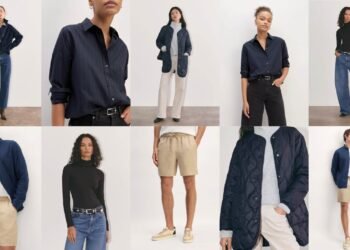Creative playfulness and innovation are infusing the city’s fashion scene too, from little ateliers like the workshop run by dressmaker Marta Ferri, who pairs sneakers with her evening wear, to a new breed of thrift store like Bivio, opened by American Hilary Belle Walker. On the rooftop of her attic apartment on Via Larga, Pia Zanardi—wearing a well-loved T-shirt from the Lyford Cay Club in the Bahamas—shows me the spot where she hosts dinner parties overlooking the Duomo. She moved back to Milan to grow her Yali label after stints in Beijing, Shanghai, and New York, where she first worked in a skate shop. The Yali aesthetic is a high-low mix of elegance and street style, from velvet blazers inspired by Chinese tangzhuang coats to psychedelic silk pants, with plans for hoodies and more conventional streetwear in upcoming collections. Despite influences ranging from ’90s punk graphics to filmmaker Wong Kar-wai, Zanardi says it helps to be in the city of Versace, Armani, and Gianfranco Ferré—and not just because she’s currently obsessed with vintage Miu Miu and Prada. “I’ve realized how much energy it gives me to be in this city of fashion production and proper craftspeople, which has always drawn creative people,” she says. “And the cultural mix here is only getting better. It’s all happening now.”
Milan’s next generation doesn’t see itself as being in competition with the fashion houses or design greats but as standing on the shoulders of its forebears—not least because the big labels have often been good for Milan. Near the Porta Romana station in Morivione, where Marchesani lives, the arrival in 2015 (the same year as the game-changing Milan Expo) of the Fondazione Prada, the fashion house’s celebrated contemporary art museum, not only signaled an upturn in the area’s fortunes but also created a center for avant-garde arts and culture. The area is now full of whimsical spaces, like Bar Luce.
And while Ferragamo will always be a Florentine brand, Leonardo Ferragamo, Salvatore’s fifth son, is the brains behind the new Portrait Milano hotel, which has breathed new life into the colonnaded Piazza del Quadrilatero, a 16th-century former seminary in the center of town. Part of the new development, which also includes a bustling outpost of Beefbar, the venerable European steakhouse, is the first store for So-Le Studio, the nascent jewelry-and-handbag brand from Maria Sole Ferragamo, one of Salvatore’s granddaughters. In the spirit of his designs (including his iconic wedges made with recycled wine corks), she started her label using leather and brass scraps from Ferragamo’s workshops in Tuscany, transforming them into sculptural amulets, ear cuffs, and architectural bags. “Everything here is a bike ride or walk away,” says Maria, who has a studio in the Portello district, once home to Alfa Romeo’s first production plant and now the site of galleries and artist collectives. “And in a short distance, there’s so much to be inspired by.”
While the city’s creatives are on a hot streak, the very fabric of Milan seems to be evolving. Driving past the futuristic circular buildings of the new campus of the Bocconi economics university, designed by the Japanese architecture firm Sanaa, I’m struck by a woman collecting poppy seeds in a meadow of wildflowers planted in front of the school. It fits with a new passion for nature in the city, epitomized by Bosco Verticale, a residential tower by the Milanese architect and urban planner Stefano Boeri, bursting with 21,000 plants and 20 bird species. Now Boeri is a key figure behind Forestami, an urban-forestry project that has already planted 427,475 trees, with the goal of introducing three million by 2030. “When I grew up here, Milan was gray, industrial, and polluted,” Boeri tells me when we meet in his office. “But that’s changing.” His happy place to stroll is the Renata Tebaldi community gardens, named after the late Italian soprano. “I can see the magnolias bloom here before they do in the rest of the city. These trees are a unique hybrid—a miracle, a bit like Milan.”














